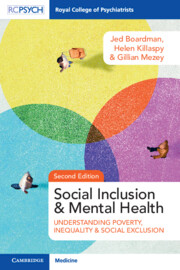Book contents
- Social Inclusion and Mental Health
- Reviews
- Social Inclusion and Mental Health
- Copyright page
- Contents
- Foreword to Second Edition
- Foreword to First Edition (2010)
- Preface
- Acknowledgements
- Chapter 1 Introduction: Poor, Excluded, and Unequal
- Section 1 Social Exclusion, Poverty, and Inequality
- Chapter 2 Social Exclusion: Basic Concepts
- Chapter 3 Social Exclusion: Applying the Paradigm to People with Mental Health Conditions – Key Aspects
- Chapter 4 Poverty and Deprivation: Getting Under the Skin
- Chapter 5 Poverty, Deprivation, and Social Exclusion in the United Kingdom
- Chapter 6 Poverty, Inequality, and Health
- Chapter 7 Social Policy, the Welfare State, and Social Exclusion
- Chapter 8 Mental Health Services and Policy in the United Kingdom
- Section 2 Participation of People with Mental Health Conditions
- Section 3 Including People
- Index
- References
Chapter 5 - Poverty, Deprivation, and Social Exclusion in the United Kingdom
from Section 1 - Social Exclusion, Poverty, and Inequality
Published online by Cambridge University Press: 24 November 2022
- Social Inclusion and Mental Health
- Reviews
- Social Inclusion and Mental Health
- Copyright page
- Contents
- Foreword to Second Edition
- Foreword to First Edition (2010)
- Preface
- Acknowledgements
- Chapter 1 Introduction: Poor, Excluded, and Unequal
- Section 1 Social Exclusion, Poverty, and Inequality
- Chapter 2 Social Exclusion: Basic Concepts
- Chapter 3 Social Exclusion: Applying the Paradigm to People with Mental Health Conditions – Key Aspects
- Chapter 4 Poverty and Deprivation: Getting Under the Skin
- Chapter 5 Poverty, Deprivation, and Social Exclusion in the United Kingdom
- Chapter 6 Poverty, Inequality, and Health
- Chapter 7 Social Policy, the Welfare State, and Social Exclusion
- Chapter 8 Mental Health Services and Policy in the United Kingdom
- Section 2 Participation of People with Mental Health Conditions
- Section 3 Including People
- Index
- References
Summary
Here we look at poverty from a quantitative viewpoint to examine trends over time as well as highlighting the social and demographic groups who are most disadvantaged. This reveals a section of society that faces the hardship of life on reduced resources and that lack the necessities for daily living. It also shows the central role that poverty plays in the notion of social exclusion, particularly in exclusion from social activities. Since the 1970s there has been an increase in poverty in the UK, alongside an increase in the cost of key necessities such as energy and housing costs. unstable and under-employment, problem debt. and financial instability, alongside stringent reforms of the social security system, all of which have disproportionately affected those on low incomes. Associated with these has been an increase in material deprivation and the dramatic rise in foodbanks, and we see increasingly precarious and risky lives lived by significant sections of the population. This changing social and economic environment has implications both for the quality of life of people living with mental health conditions as well as the health and well-being of significant numbers of the general population.
Keywords
- Type
- Chapter
- Information
- Social Inclusion and Mental HealthUnderstanding Poverty, Inequality and Social Exclusion, pp. 87 - 115Publisher: Cambridge University PressPrint publication year: 2022

